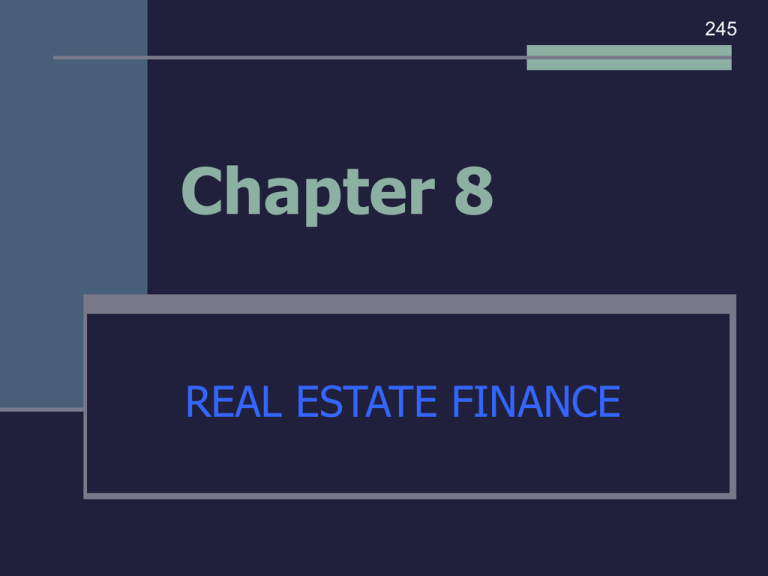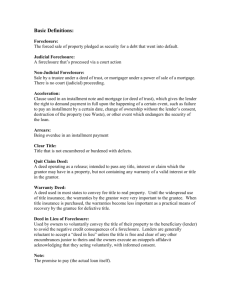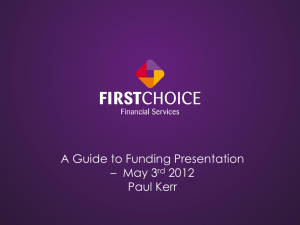
245
Chapter 8
REAL ESTATE FINANCE
245
Real Estate is expensive compared to most
other possessions. A Buyer generally puts
20% down and must obtain a loan for the
remaining 80% of the purchase price.
245
Leverage The practice of purchasing real estate using a
small amount of your own money and a
larger proportion of borrowed funds.
248
I. HYPOTHECATION
245
248
II. THE PROMISSORY NOTE
248
A Promissory note is
the basic instrument
used to evidence an
obligation or debt.
Principal is the dollar
amount of the loan.
Interest is the rent
charged for the use of
the money.
248
A. Straight Note -
Is a promissory note in which a borrower
repays the principal in one lump sum, at
maturity, while interest is paid in installments
or at maturity.
B. Installment Note
(with a balloon payment) Periodic payment of principle and interest
with a large payment at the end (maturity
date or due date).
248-249
C. Fully Amortized
Installment Note -
249
Periodic payments of principal and interest in
equal installments until the debt is paid in
full.
The most commonly used type of note in
California.
250
III. NEGOTIABLE
INSTRUMENTS
250
A NEGOTIABLE INSTRUMENT is any
financial document (promissory note, check,
or other) that can be passed easily from one
person to another, if it meets certain legal
requirements.
A. Promissory Notes,
Checks, Others Negotiable instruments must be:
an unconditional promise
in writing
made by one person to another
signed by the maker
payable on demand
for a set amount of money.
250
251
B. Holder in Due Course One who has taken a negotiable instrument
from another, in good faith, without
knowledge of defect.
251
IV. IMPORTANT
CLAUSES IN
FINANCING
INSTRUMENTS
251
A. Acceleration Clause Upon occurrence of a specific event, the
lender has the right to demand immediate
payment of the entire note.
B. Alienation Clause
(Due on Sale) The entire loan becomes due and payable
when the property is sold, assigned,
transferred, or otherwise alienated.
251
C. Assumption -
251
Buying a property that is already encumbered
and accepting responsibility, with the lender’s
consent, for the full payment of the loan.
252
Taking title SUBJECT TO Buying a property and taking over payment
of existing loans on behalf of the seller who is
still responsible to the lender because the
loan is still officially in his or her name.
252
D. Subordination Clause Allows for a future change in the priority of
financial liens on a property.
252
E. Prepayment Penalties Charges to the borrower for paying off a loan
before the due date.
F. Impound Accounts
(Reserves) Moneys collected in advance from borrowers
to assure the payment of recurring costs,
such as property taxes and fire insurance.
252
253
G. Assignment of Rents Allows a lender, upon default of the borrower,
to take possession of the property, collect
rents, and pay expenses.
253
V. INTEREST AND TYPES
OF LOANS
253
A. Interest The lender's charge for borrowing money.
NOMINAL INTEREST RATE – is the rate
stated in the note.
EFFECTIVE INTEREST RATE – is the rate
the borrower is actually paying (including
interests, points, and loan fees).
I=PxRxT
Interest = Principal x Rate x Time
253
B. Fixed Interest Rates -
Payments are the same each month for the
life of the loan.
253
C. Amortization Payments The repaying of a loan (principal and
interest), in regular payments, over the term
of the loan.
254
254
Negative Amortization The interest rate charges are higher than the
monthly payment.
D. Adjustable Rate Mortgage
(ARM) A loan in which the interest rate fluctuates
periodically, based on a specific index, which
makes the payment amount also change.
254
E. Some Special Purpose
Types of Loans
257
Graduated Payment Mortgage - A fixed rate
loan where payments early on are low, but increase
later to a higher level.
Biweekly Mortgage (26 Payments) - A
fixed interest rate loan for which the payments are
made every two weeks, but each payment is one-half
the amount of a regular monthly payment.
257
15-Year Fixed and Adjustable Rate
Loans - Loans gaining in popularity because, for a
slight increase in the monthly payment, the loan can
be paid off in only 15 years.
Reverse Annuity Loans (Seniors Who
Need Income) - loans in which the lender pays
the borrower a fixed monthly payment based on the
value of the property. The loan is not repaid until the
last owner dies or the property is sold, at which time
it is paid back through probate.
257
VI. POINTS, LOAN FEES,
AND USURY
257
A. Points A originationfee of 1% of the principal loan
amount which the borrower pays to the
lender.
258
B. Loan Fees The fee charges by the lender in order to
apply for a loan.
258
C. Usury Charging more than the legally allowed percentage of
interest.
The constitutional rate in California is 10%, or 5% above
the Federal Reserve Bank of San Francisco, whichever is
higher.
Most public sources of real estate funds are exempted
from usury limits, including agreements arranged
through brokers and salespeople.
www.frbsf.org
Federal Reserve Bank of San Francisco
258
VII. SECURITY DEVICES
259
A. Mortgage A financial
instrument, in the
form of a lien, that
secures a property
for payment of a
promissory note
(rare in California)
259
Parties to a mortgage:
Mortgagor - party who is borrowing.
Mortgagee - lender and holds title to the
property.
259
1. Power of Sale Clause Allows mortgagee to sell property without a
court proceeding if mortgagor is in default.
2. Mortgages Compared
to Trust Deeds
Parties
a. Mortgage - two
b. Trust Deed - three
Title
a. Mortgage - does not
convey title, it creates a
lien.
b. Trust Deed - title
conveyed to a trustee
(is in effect a lien).
259-262
Statute of Limitations
a. Mortgage - mortgagee
has 4 years to start
foreclosure.
b. Trust Deed - no time
limit.
Remedy for Default
a. Mortgage - foreclosure
only remedy, unless there
is a power of sale clause.
Redemption period - 1
year.
b. Trust Deed - entire
process takes 4 months.
3. Trust Deeds are Preferred
to Mortgages
Fewer restrictions for lender.
Short period of redemption.
Immediate possession (wipes out trustor’s
interest).
California law favors lenders who use trust
deeds.
262
262
B. Trust Deed A security device that makes real property collateral for a
promissory note. Rare in California.
Parties to a trust deed:
a. Trustor - the party who is borrowing the money.
a. holds equitable title to the property.
b. is entitles to ownership, use and possession.
b. Beneficiary - the lender.
c. Trustee - the third party who must sell the property for
the beneficiary if the trustor defaults.
1. generally a title insurance company.
2. holds legal title only (“bare naked title”) until trust deed is paid
in full).
265
3. Deed of Reconveyance
(Proof of Payment in Full) -
266
Provides proof that a promissory note and the
accompanying trust deed have been paid in
full.
266
VIII. DEFAULT AND
FORECLOSURE OF A TRUST
DEED
266
A. Default on a Trust Deed A borrower's failure to make payments and
properly repay the loan.
266
Grace Period A set number of days in which a lender will
allow payments to be late without any
penalty.
269
Notice of Default Trustee files this legal
notice and has it
recorded and
published to inform
the trustor
(borrower) and other
interested parties
that a default or
foreclosure action
has started.
B. Trustor’s Right of
1. Reinstatement Period The three-month period during which the
trustor may reinstate the loan by paying
1. All past-due:
a.
b.
c.
d.
Payments
Penalties
Taxes
Interest.
2. Any other costs to the beneficiary.
3. All costs and fees owed the trustee.
269
269
2. Notice of Sale Recorded notice stating the time, place,
property, and type of sale.
Recorded by trustee if loan is not reinstated.
Must be published in a newspaper of general
circulation at least once a week, for 21 days.
Must be posted on the property and in a public
place.
271
3. Trustee's Sale Public sale of foreclosed property by the trustee
All bids must be in cash or cashier's check.
Beneficiary may bid up to the amount of debt without cash.
Highest bidder is issued a trustee's deed.
New owner gets immediate possession (no redemption).
Any money in excess of the debt is awarded to the trustor.
271
4. JUDICIAL COURT FORCLOSURE FOR A
TRUST DEED –In rare case, a beneficiary in
California may want to foreclose by court
action instead of a trustee’s sale.
5. DEED IN LIEU OF FORECLOSURE – a deed
given by an owner (borrower) to a lender to
prevent the lender from bringing foreclosure
proceedings.
C. Liens Not Eliminated by
Foreclosure Sale Most junior liens are eliminated by a
foreclosure sale.
The following liens are not necessarily
eliminated:
Federal tax liens
State, county, and city taxes or assessments
Mechanic’s liens for work begun before the trust
deed was recorded.
271
D. Purchase Money Trust
Deed or Mortgage -
271
A trust deed or mortgage obtained during the
purchase of a home (1-to-4 units, owneroccupied).
It is called a purchase money instrument only
when it is obtained at the time of purchase,
not on a refinanced loan.
272
Deficiency Judgment Given when the security pledge for a loan
does not satisfy the debt upon its default.
272
IX. SECOND TRUST DEEDS
(JUNIOR TDs)
272
A. Junior Liens Any loan on
real property
obtained after
the first trust
deed.
Usually a
private party.
273
B. Homeowner Equity Loans Loans based on the homeowner’s increase in
equity caused by inflation, rising property
values, and the reduction, by payments, of
the existing loan balance.
C. Holder of A Second Trust
Deed (Lender) Sometimes when purchasing a property,
additional funds will be required beyond the
cash down payment and the first trust deed.
As a result, the seller may loan the buyer
more money through the use of a second
trust deed.
273
273
D. Request for Notice When recorded, the trustee is required to
notify all persons who request notice if a
“notice of default” is recorded on a particular
property.
Any person who has an interest in a particular
trust deed, usually a second or third trust
deed holder, should want to be informed if the
buyer is not paying on the first deed of trust.
E. Wrap-Around—All inclusive
trust deeds (AITD) -
274
A second trust deed with a face value of both
the new amount it secures and the balance
due under the first trust deed.
274
X. LAND CONTRACT
274
An instrument of finance
where the seller retains
legal ownership of the
property until the buyer
has made the last
payment.
Not that common in
California.
274
Also called:
Contract of Sale
Agreement of Sale
Conditional Sales Contract
Installment Sales Contract
Parties to a land
contract are:
276
Seller
Also known as Vendor.
Holds legal title to the property until all terms
and payments are fulfilled (paid in full).
Buyer
Also known as Vendee.
Holds equitable title to the property (the right to
use and possess).
276
XI. TRUTH IN LENDING
ACT
(REGULATION Z AND
OTHER ACTS)
276
A. Truth in Lending Act The Truth in Lending Act, known as
Regulation Z, was enacted to protect the
consumer by requiring that the lender
(creditor) tell the borrower how much he or
she is paying for credit.
Regulation Z also states that the lender
(creditor) must express all related financing
costs as a percentage, known as the annual
percentage rate (APR).
Regulation Z requires a creditor to
make the following important
financial disclosures:
Annual Percentage Rate (APR)
Finance charges
Amount financed
Total number of payments
Total sales price (credit sales)
The two most important items, according to
Regulation Z, are the APR and the amount
financed.
276
1. Annual Percentage Rate
(APR) -
278
The measure or “cost of credit” expressed as
a yearly rate. It is a percentage rate, not an
interest rate.
The APR includes all “finance charges,”
including assumption charges, but it does not
include:
cost of a credit report
appraisal fees, which are exempt.
2. Advertising Terms May
Require Additional Disclosures -
278
Anyone placing an advertisement for
consumer credit must comply with the
advertising requirements of the Truth in
Lending Act.
Disclosures must be made “clearly and
conspicuously.”
278
If an advertisement contains any one of the
following terms, then the ad must disclose
other credit terms:
The amount or percentage of any down
payment.
The number of payments or period of repayment.
The amount of any payment.
The amount of any finance charge.
B. Right to Cancel
285
(Federal Notice of Right to Cancel) Loans subsequent (future loans) have a 3-day
right of rescission by the borrower.
285
C. Equal Credit Opportunity Act A federal law prohibiting those who lend
money from discriminating against borrowers
based on their race, sex, color, religion,
national origin, age, or marital status.
This law limits the lender’s access to
personal information regarding:
marriage and divorce,
receipt of alimony and child support, and
birth control and child bearing.
285
D. Soldiers and Sailors Civil
Relief Act -
285
A law passed by Congress to protect persons
serving in the military, and their dependents,
from loss of real property through
foreclosure.
288
Chapter 8 Summary
Leverage
Hypothecate
Acceleration clause
Alienation clause
Subordination clause
Prepayment penalty
Promissory Note
Straight
Installment w/balloon
payment
Fully amortized
Fully negotiable
Holder in due course
Interest
Simple
Nominal
Effective
I=PxRxT
Fixed
Amortization
ARM
Negative Amortization
289
Chapter 8 Summary
Points
Usury
Financial Instruments
Mortgage
Trust Deeds
Land Contracts
Trust Deeds
Note
Beneficiary
Trustor
Trustee
Equitable title
“Bare naked” title
Full Reconveyance
Defaults
Default action
Foreclosure
Junior Liens
Private lenders
287
Chapter 8 Summary
Land Contract
Vendor
Vendee
Wrap-around
Truth in Lending (Regulation Z)
APR
Right to rescind
Equal Credit Opportunity Act
Soldiers and Sailors Civil Relief Act












